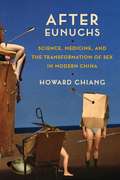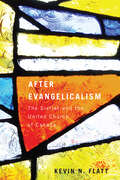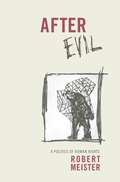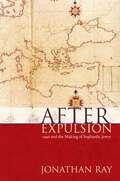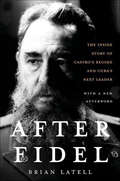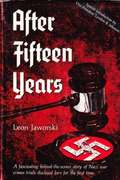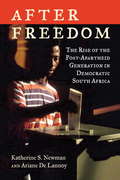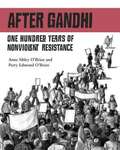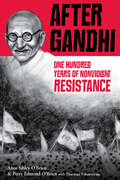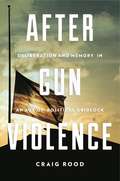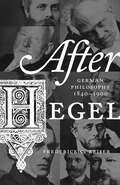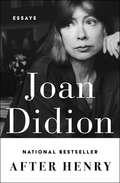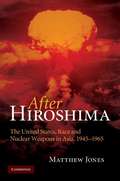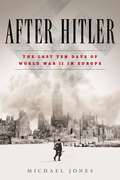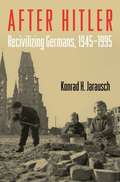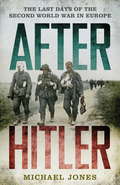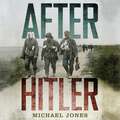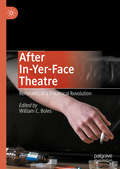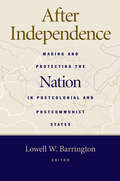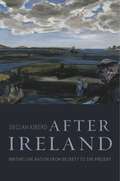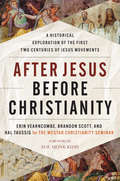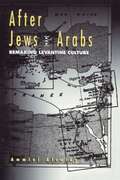- Table View
- List View
After Eunuchs: Science, Medicine, and the Transformation of Sex in Modern China
by Howard ChiangFor much of Chinese history, the eunuch stood out as an exceptional figure at the margins of gender categories. Amid the disintegration of the Qing Empire, men and women in China began to understand their differences in the language of modern science. In After Eunuchs, Howard Chiang traces the genealogy of sexual knowledge from the demise of eunuchism to the emergence of transsexuality, showing the centrality of new epistemic structures to the formation of Chinese modernity.From anticastration discourses in the late Qing era to sex-reassignment surgeries in Taiwan in the 1950s and queer movements in the 1980s and 1990s, After Eunuchs explores the ways the introduction of Western biomedical sciences transformed normative meanings of gender, sexuality, and the body in China. Chiang investigates how competing definitions of sex circulated in science, medicine, vernacular culture, and the periodical press, bringing to light a rich and vibrant discourse of sex change in the first half of the twentieth century. He focuses on the stories of gender and sexual minorities as well as a large supporting cast of doctors, scientists, philosophers, educators, reformers, journalists, and tabloid writers, as they debated the questions of political sovereignty, national belonging, cultural authenticity, scientific modernity, human difference, and the power and authority of truths about sex. Theoretically sophisticated and far-reaching, After Eunuchs is an innovative contribution to the history and philosophy of science and queer and Sinophone studies.
After Evangelicalism
by Kevin N. FlattAt a time when Canadians were arguing about the merits of a new flag, the birth-control pill, and the growing hippie counterculture, the leaders of Canada's largest Protestant church were occupied with turning much of English-Canadian religious culture on its head. In After Evangelicalism, Kevin Flatt reveals how the United Church of Canada abruptly reinvented its public image by cutting the remaining ties to its evangelical past. Flatt argues that although United Church leaders had already abandoned evangelical beliefs three decades earlier, it was only in the 1960s that rapid cultural shifts prompted the sudden dismantling of the church's evangelical programs and identity. Delving deep into the United Church's archives, Flatt uncovers behind-the-scenes developments that led to revolutionary and controversial changes in the church's evangelistic campaigns, educational programs, moral stances, and theological image. Not only did these changes evict evangelicalism from the United Church, but they helped trigger the denomination's ongoing numerical decline and decisively changed Canada's religious landscape. Challenging readers to see the Canadian religious crisis of the 1960s as involving more than just Quebec's Quiet Revolution, After Evangelicalism unveils the transformation of one of Canada's most prominent social institutions.
After Evil: A Politics of Human Rights (Columbia Studies In Political Thought/political History)
by Robert MeisterThe way in which mainstream human rights discourse speaks of such evils as the Holocaust, slavery, or apartheid puts them solidly in the past. Its elaborate techniques of "transitional" justice encourage future generations to move forward by creating a false assumption of closure, enabling those who are guilty to elude responsibility. This approach to history, common to late-twentieth-century humanitarianism, doesn't presuppose that evil ends when justice begins. Rather, it assumes that a time before justice is the moment to put evil in the past. Merging examples from literature and history, Robert Meister confronts the problem of closure and the resolution of historical injustice. He boldly challenges the empty moral logic of "never again" or the theoretical reduction of evil to a cycle of violence and counterviolence, broken only once evil is remembered for what it was. Meister criticizes such methods for their deferral of justice and susceptibility to exploitation and elaborates the flawed moral logic of "never again" in relation to Auschwitz and its evolution into a twenty-first-century doctrine of the Responsibility to Protect.
After Expulsion: 1492 and the Making of Sephardic Jewry
by Jonathan S RayA &“groundbreaking&” portrait of the migration and resettlement of Spain&’s Jewish community after 1492, and how the Sephardic identity emerged (American Historical Review). Honorable Mention, Jordan Schnitzer Book Award in Medieval and Early Modern Jewish History presented by the Association for Jewish Studies On August 3, 1492, the same day that Columbus set sail from Spain, the long and glorious history of that nation&’s Jewish community officially came to a close. The expulsion of Europe&’s last major Jewish community ended more than a thousand years of unparalleled prosperity, cultural vitality, and intellectual productivity. Yet, the crisis of 1492 also gave rise to a dynamic and resilient diaspora society spanning East and West. After Expulsion traces the various paths of migration and resettlement of Sephardic Jews and Conversos over the course of the tumultuous sixteenth century. Pivotally, the volume argues that the exiles did not become &“Sephardic Jews&” overnight. Only in the second and third generation did these disparate groups coalesce and adopt a &“Sephardic Jewish&” identity. This is a new and fascinating portrait of Jewish society in transition from the medieval to the early modern period—a portrait that challenges many longstanding assumptions about the differences between Europe and the Middle East. &“A rich and compelling history . . . With its intense focus on one century, Ray&’s book makes a distant time and trauma painfully vivid and immediate to the reader.&” ―Jewish Currents Magazine
After Fidel: The Inside Story of Castro's Regime and Cuba's Next Leader
by Brian LatellThis is a compelling behind-the-scenes account of the extraordinary Castro brothers and the dynastic succession of Fidel's younger brother Raul. Brian Latell, the CIA analyst who has followed Castro since the sixties, gives an unprecedented view into Fidel and Raul's remarkable relationship, revealing how they have collaborated in policy making, divided responsibilities, and resolved disagreements for more than forty years--a challenge to the notion that Fidel always acts alone. Latell has had more access to the brothers than anyone else in this country, and his briefs to the CIA informed much of U.S. policy. Based on his knowledge of Raul Castro, Latell makes projections on what kind of leader Raul will be and how the shift in power might influence U.S.-Cuban relations.
After Fifteen Years
by Leon JaworskiA Fascinating Behind-The-Scenes Story Of Nazi War Crimes Trials Disclosed Here For The First TimeLeon Jaworski was a prodigal lawyer, the youngest person ever to be admitted to the Texas Bar and was involved in some of the important cases in legal history. His enduring fame came from leading the prosecution of the Watergate case, United States v Nixon, and heading the large Texas based law firm Fulbright and Jaworski.Jaworski wrote a number of autobiographical books, in this, his first volume of memoirs, he reflects on his wartime career during which he served in the United States Army judge advocate general's department . He was made chief of the trial section of the war crimes branch in the late stages of the war in Europe. In this office he directed investigations of several hundred cases concerning German crimes against persons living and fighting in the American zone of occupation. He also personally tried two cases--the first having to do with the murder of American aviators shot down over Germany in 1944 and the second involving the doctors and staff of a German sanatorium where Polish and Russian prisoners were put to death. Jaworski had risen to the rank of colonel by the time he returned to civilian life in October 1945.
After Freedom
by Katherine S. Newman Ariane De LannoyTwenty years after the end of apartheid, a new generation is building a multiracial democracy in South Africa but remains mired in economic inequality and political conflict. This spring, South Africa will celebrate the twentieth anniversary of the fall of apartheid and the first free elections. Although the country has come far, frustration is growing as inequalities that once divided the races now grow within them. In After Freedom, award-winning sociologist Katherine S. Newman and South African expert Ariane De Lannoy profile seven people--Black, White, "Coloured," and immigrant--to reveal what life is like in South Africa today. These on-the-ground portraits offer an intimate look at the rising generation of young people and explore what the complex political landscape means to the average person. After Freedom is a timely look at how the generation that came of age post-apartheid is grappling with a tenuous democracy in a globalized economy.
After Gandhi: One Hundred Years of Nonviolent Resistance
by Anne Sibley O'Brien Perry Edmond O'BrienThis book explores the work of Mohandas Gandhi and his legacy through fifteen profiles of activists who chose nonviolent resistance as the path to change. The book focuses on heroic individuals who were in direct physical danger and chose to respond with nonviolence.
After Gandhi: One Hundred Years of Nonviolent Resistance
by Anne Sibley O'BrienIn 1908 Mohandas Gandhi spoke to a crowd of 3,000. Together they protested against an unjust law without guns or rioting. Peacefully they made a difference. Gandhi’s words and deeds influenced countless others to work toward the goals of freedom and justice through peaceful methods. Mother and son team, Anne Sibley O’Brien and Perry Edmond O’Brien, highlight some of the people and events that Gandhi’s actions inspired. From Rosa Parks to the students at Tiananmen Square to Wangari Maathai, these people have made the world sit up and take notice. The provocative graphics and beautiful portraits accompanying these stories stir the emotions and inspire a sense of civic responsibility.
After Gun Violence: Deliberation and Memory in an Age of Political Gridlock (Rhetoric and Democratic Deliberation #21)
by Craig RoodMass shootings have become the “new normal” in American life. The same can be said for the public debate that follows a shooting: blame is cast, political postures are assumed, but no meaningful policy changes are enacted. In After Gun Violence, Craig Rood argues that this cycle is the result of a communication problem. Without advocating for specific policies, Rood examines how Americans talk about gun violence and suggests how we might discuss the issues more productively and move beyond our current, tragic impasse.Exploring the ways advocacy groups, community leaders, politicians, and everyday citizens talk about gun violence, Rood reveals how the gun debate is about far more than just guns. He details the role of public memory in shaping the discourse, showing how memories of the victims of gun violence, the Second Amendment, and race relations influence how gun policy is discussed. In doing so, Rood argues that forgetting and misremembering this history leads interest groups and public officials to entrenched positions and political failure and drives the public further apart.Timely and innovative, After Gun Violence advances our understanding of public discourse in an age of gridlock by illustrating how public deliberation and public memory shape and misshape one another. It is a search to understand why public discourse fails and how we can do better.
After Gun Violence: Deliberation and Memory in an Age of Political Gridlock (Rhetoric and Democratic Deliberation)
by Craig RoodMass shootings have become the “new normal” in American life. The same can be said for the public debate that follows a shooting: blame is cast, political postures are assumed, but no meaningful policy changes are enacted. In After Gun Violence, Craig Rood argues that this cycle is the result of a communication problem. Without advocating for specific policies, Rood examines how Americans talk about gun violence and suggests how we might discuss the issues more productively and move beyond our current, tragic impasse.Exploring the ways advocacy groups, community leaders, politicians, and everyday citizens talk about gun violence, Rood reveals how the gun debate is about far more than just guns. He details the role of public memory in shaping the discourse, showing how memories of the victims of gun violence, the Second Amendment, and race relations influence how gun policy is discussed. In doing so, Rood argues that forgetting and misremembering this history leads interest groups and public officials to entrenched positions and political failure and drives the public further apart.Timely and innovative, After Gun Violence advances our understanding of public discourse in an age of gridlock by illustrating how public deliberation and public memory shape and misshape one another. It is a search to understand why public discourse fails and how we can do better.
After Hegel: German Philosophy, 1840–1900
by Frederick C. BeiserHistories of German philosophy in the nineteenth century typically focus on its first half—when Hegel, idealism, and Romanticism dominated. By contrast, the remainder of the century, after Hegel's death, has been relatively neglected because it has been seen as a period of stagnation and decline. But Frederick Beiser argues that the second half of the century was in fact one of the most revolutionary periods in modern philosophy because the nature of philosophy itself was up for grabs and the very absence of certainty led to creativity and the start of a new era. In this innovative concise history of German philosophy from 1840 to 1900, Beiser focuses not on themes or individual thinkers but rather on the period’s five great debates: the identity crisis of philosophy, the materialism controversy, the methods and limits of history, the pessimism controversy, and the Ignorabimusstreit. Schopenhauer and Wilhelm Dilthey play important roles in these controversies but so do many neglected figures, including Ludwig Büchner, Eugen Dühring, Eduard von Hartmann, Julius Fraunstaedt, Hermann Lotze, Adolf Trendelenburg, and two women, Agnes Taubert and Olga Pluemacher, who have been completely forgotten in histories of philosophy. The result is a wide-ranging, original, and surprising new account of German philosophy in the critical period between Hegel and the twentieth century.
After Henry: Essays
by Joan DidionIncisive essays on Patty Hearst and Reagan, the Central Park jogger and the Santa Ana winds, from the New York Times–bestselling author of South and West. In these eleven essays covering the national scene from Washington, DC; California; and New York, the acclaimed author of Slouching Towards Bethlehem and The White Album &“capture[s] the mood of America&” and confirms her reputation as one of our sharpest and most trustworthy cultural observers (The New York Times). Whether dissecting the 1988 presidential campaign, exploring the commercialization of a Hollywood murder, or reporting on the &“sideshows&” of foreign wars, Joan Didion proves that she is one of the premier essayists of the twentieth century, &“an articulate witness to the most stubborn and intractable truths of our time&” (Joyce Carol Oates, The New York Times Book Review). Highlights include &“In the Realm of the Fisher King,&” a portrait of the White House under the stewardship of Ronald and Nancy Reagan, two &“actors on location;&” and &“Girl of the Golden West,&” a meditation on the Patty Hearst case that draws an unexpected and insightful parallel between the kidnapped heiress and the emigrants who settled California. &“Sentimental Journeys&” is a deeply felt study of New York media coverage of the brutal rape of a white investment banker in Central Park, a notorious crime that exposed the city&’s racial and class fault lines. Dedicated to Henry Robbins, Didion&’s friend and editor from 1966 until his death in 1979, After Henry is an indispensable collection of &“superior reporting and criticism&” from a writer on whom we have relied for more than fifty years &“to get the story straight&” (Los Angeles Times).
After Hiroshima
by Matthew JonesBy emphasising the role of nuclear issues, After Hiroshima provides a new history of American policy in Asia between the dropping of the atomic bombs on Japan and the escalation of the Vietnam War. Drawing on a wide range of documentary evidence, Matthew Jones charts the development of American nuclear strategy and the foreign policy problems it raised, as the United States both confronted China and attempted to win the friendship of an Asia emerging from colonial domination. In underlining American perceptions that Asian peoples saw the possible repeat use of nuclear weapons as a manifestation of Western attitudes of 'white superiority', he offers new insights into the links between racial sensitivities and the conduct of US policy, and a fresh interpretation of the transition in American strategy from massive retaliation to flexible response in the era spanned by the Korean and Vietnam Wars.
After Hitler
by Michael JonesFrom the acclaimed author of The King's Mother and Bosworth 1485--a fascinating look at ten days that changed the course of history...With the world at war, ten days can feel like a lifetime.... On April 30, 1945, Adolf Hitler committed suicide in a bunker in Berlin. But victory over the Nazi regime was not celebrated in western Europe until May 8, and in Russia a day later, on the ninth. Why did a peace agreement take so much time? How did this brutal, protracted conflict coalesce into its unlikely endgame? After Hitler shines a light on ten fascinating days after that infamous suicide that changed the course of the twentieth century. Combining exhaustive research with masterfully paced storytelling, Michael Jones recounts the Führer's frantic last stand; the devious maneuverings of his handpicked successor, Karl Dönitz; the grudging respect Joseph Stalin had for Churchill and FDR, as well as his distrust of Harry Truman; the bold negotiating by General Dwight D. Eisenhower that hastened Germany's surrender but drew the ire of the Kremlin; the journalist who almost scuttled the cease-fire; and the thousands of ordinary British, American, and Russian soldiers caught in the swells of history, from the Red Army's march on Berlin to the liberation of the Nazis' remaining concentration camps. Through it all, Jones traces the shifting loyalties between East and West that sowed the seeds of the Cold War and nearly unraveled the Grand Alliance. In this gripping, eloquent, and even-handed narrative, the spring of 1945 comes alive--a fascinating time when nothing was certain, and every second mattered....INCLUDES PHOTOSFrom the Hardcover edition.
After Hitler: Recivilizing Germans, 1945-1995
by Konrad H. Jarausch Konrad HunzikerIn the spring of 1945, as the German army fell in defeat and the world first learned of the unspeakable crimes of the Holocaust, few would have expected that, only half a century later, the Germans would emerge as a prosperous people at the forefront of peaceful European integration. How did the Germans manage to recover from the shattering experience of defeat in World War II and rehabilitate themselves from the shame and horror of the Holocaust? In After Hitler, Konrad H. Jarausch shows how Germany's determination to emphasize civility and civil society, destroyed by the Nazi regime,helped restore the demoralized nation during the post-war period. Unlike other intellectual inquiries into German efforts to deal with the Nazi past, After Hitler primarily focuses on the practical lessons a disoriented people drew from their past misdeeds, and their struggle to create a new society with a sincere and deep commitment to human rights. After Hitler offers a comprehensive view of the breathtaking transformation of the Germans from the defeated Nazi accomplices and Holocaust perpetrators of 1945 to the civilized, democratic people of today's Germany.
After Hitler: The Last Days of the Second World War in Europe
by Michael JonesOn 30 April 1945, Adolf Hitler committed suicide. The following day, his propaganda minister Joseph Goebbels also killed himself and the crumbling Third Reich passed to Admiral Karl Dönitz. The Nazis' position seemed hopeless. Yet remarkably, the war in the rest of Europe went on for another ten days. After Hitler looks at these days as a narrative day-by-day countdown but also as a broader global history of a European war that had seen some of the most savage battles in history. Relations between the 'Big Three' - the United States, Great Britain and the Soviet Union - suddenly plunged to near breaking point. This book reveals that tumultuous story.After Hitler also looks at the wider canvas of the war and the terrible humanitarian catastrophe uncovered in Europe. It describes those who felt the joy of freedom, but also those who faced a highly uncertain future. As Red Army soldiers joined forces with their British and American allies, Stalin's East finally came face to face with Churchill's and Truman's West. After Hitler tells of their growing mistrust, but also of moments of remarkable goodwill and co-operation - the brief but poignant hope that these great nations could together fashion a new and safer future. This is a fascinating exploration of the brief but crucial period that shaped the emerging post-war world.
After Hitler: The Last Days of the Second World War in Europe
by Michael JonesOn 30 April 1945, Adolf Hitler committed suicide. The following day, his propaganda minister Joseph Goebbels also killed himself and the crumbling Third Reich passed to Admiral Karl Dönitz. The Nazis' position seemed hopeless. Yet remarkably, the war in the rest of Europe went on for another ten days. After Hitler looks at these days as a narrative day-by-day countdown but also as a broader global history of a European war that had seen some of the most savage battles in history. Relations between the 'Big Three' - the United States, Great Britain and the Soviet Union - suddenly plunged to near breaking point. This book reveals that tumultuous story.After Hitler also looks at the wider canvas of the war and the terrible humanitarian catastrophe uncovered in Europe. It describes those who felt the joy of freedom, but also those who faced a highly uncertain future. As Red Army soldiers joined forces with their British and American allies, Stalin's East finally came face to face with Churchill's and Truman's West. After Hitler tells of their growing mistrust, but also of moments of remarkable goodwill and co-operation - the brief but poignant hope that these great nations could together fashion a new and safer future. This is a fascinating exploration of the brief but crucial period that shaped the emerging post-war world.
After Hitler: The Last Days of the Second World War in Europe
by Michael JonesThe fascinating and little-known history of the last days of the Second World War in Europe.On 30 April 1945, Adolf Hitler committed suicide. The following day, his propaganda minister Joseph Goebbels also killed himself and the crumbling Third Reich passed to Admiral Karl Dönitz. The Nazis' position seemed hopeless. Yet remarkably, the war in the rest of Europe went on for another ten days. After Hitler looks at these days as a narrative day-by-day countdown but also as a broader global history of a European war that had seen some of the most savage battles in history. Relations between the 'Big Three' - the United States, Great Britain and the Soviet Union - suddenly plunged to near breaking point. This book reveals that tumultuous story.After Hitler also looks at the wider canvas of the war and the terrible humanitarian catastrophe uncovered in Europe. It describes those who felt the joy of freedom, but also those who faced a highly uncertain future. As Red Army soldiers joined forces with their British and American allies, Stalin's East finally came face to face with Churchill's and Truman's West. After Hitler tells of their growing mistrust, but also of moments of remarkable goodwill and co-operation - the brief but poignant hope that these great nations could together fashion a new and safer future. This is a fascinating exploration of the brief but crucial period that shaped the emerging post-war world.(P)2018 Hodder & Stoughton Limited
After In-Yer-Face Theatre: Remnants of a Theatrical Revolution
by William C. BolesThis book revisits In-Yer-Face theatre, an explosive, energetic theatrical movement from the 1990s that introduced the world to playwrights Sarah Kane, Martin McDonagh, Mark Ravenhill, Jez Butterworth, and many others. Split into three sections the book re-examines the era, considers the movement’s influence on international theatre, and considers its lasting effects on contemporary British theatre. The first section offers new readings on works from that time period (Antony Neilson and Mark Ravenhill) as well as challenges myths created by the Royal Court Theatre about the its involvement with In-Yer-Face theatre. The second section discusses the influence of In-Yer-Face on Portuguese, Russian and Australian theater, while the final section discusses the legacy of In-Yer-Face writers as well as their influences on more recent playwrights, including chapters on Philip Ridley, Sarah Kane, Joe Penhall, Martin Crimp, Dennis Kelly, and Verbatim Drama.
After Independence: Making and Protecting the Nation in Postcolonial & Postcommunist States
by Lowell W. BarringtonThe majority of the existing work on nationalism has centered on its role in the creation of new states. After Independence breaks new ground by examining the changes to nationalism after independence in seven new states. This innovative volume challenges scholars and specialists to rethink conventional views of ethnic and civic nationalism and the division between primordial and constructivist understandings of national identity.
After Ireland: Writing the Nation from Beckett to the Present
by Declan KiberdPolitical failures and globalization have eroded Ireland’s sovereignty—a decline portended in Irish literature. Surveying the bleak themes in thirty works by modern writers, Declan Kiberd finds audacious experimentation that embodies the defiance and resourcefulness of Ireland’s founding spirit—and a strange kind of hope for a more open nation.
After Jesus Before Christianity: A Historical Exploration of the First Two Centuries of Jesus Movements
by Hal Taussig Erin Vearncombe Brandon Scott Westar Institute, TheFrom the creative minds of the scholarly group behind the groundbreaking Jesus Seminar comes this provocative and eye-opening look at the roots of Christianity that offers a thoughtful reconsideration of the first two centuries of the Jesus movement, transforming our understanding of the religion and its early dissemination.Christianity has endured for more than two millennia and is practiced by billions worldwide today. Yet that longevity has created difficulties for scholars tracing the religion’s roots, distorting much of the historical investigation into the first two centuries of the Jesus movement. But what if Christianity died in the fourth or fifth centuries after it began? How would that change how historians see and understand its first two hundred years?Considering these questions, three Bible scholars from the Westar Institute summarize the work of the Christianity Seminar and its efforts to offer a new way of thinking about Christianity and its roots. Synthesizing the institute’s most recent scholarship—bringing together the many archaeological and textual discoveries over the last twenty years—they have found: There were multiple Jesus movements, not a singular one, before the fourth centuryThere was nothing called Christianity until the third centuryThere was much more flexibility and diversity within Jesus’s movement before it became centralized in Rome, not only regarding the Bible and religious doctrine, but also understandings of gender, sexuality and morality.Exciting and revolutionary, After Jesus Before Christianity provides fresh insights into the real history behind how the Jesus movement became Christianity. After Jesus Before Christianity includes more than a dozen black-and-white images throughout.
After Jews and Arabs: Remaking Levantine Culture
by Ammiel AlcalayThis book not only makes a significant contribution to the literature but, by breaking new ground, seeks to create a new frame of reference for further studies of the Mediterranean. The author has pulled together many strands of scholarship to present a view of the Middle East that is starkly at odds with that put forth in the establishment press and academic journals - while taking care not to sacrifice the erudition and research, whether literary critical, historical or linguistic, that have traditionally sanctioned the orientalists' version of Levantine history in the service of Western control over the region.
